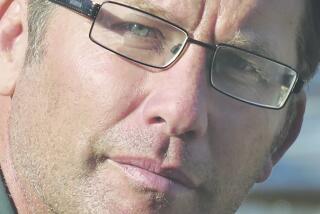The route of the ‘roo
HAS the controversial author of “The Weather Makers,” a hard-hitting international bestseller about global warming, turned away from stark findings to dash off a merry travelogue about his pursuit of those cute and funny Down-Under critters with the storybook name of kangaroo? Has mammalogist Tim Flannery decided to rest on his laurels?
Not a chance. Flannery is a scientist of conscience and a man on a mission. But in this candid, dry, witty blend of memoir and science, he does take a more covert approach to our bewildering predicament as the species responsible for causing potentially drastic climate change. Readers still encounter his ongoing amazement at the interconnectivity of life, along with his unabashed delight in the kangaroo, the unlikeliest of creatures.
Flannery’s tale begins when he was an indifferent student and a “rebellious young man” angered by the human assault against nature that prevented him from encountering such extraordinary animals as the Tasmanian tiger (the last one died “nineteen years, three months, and three weeks” before he was born). Fortunately, he finds recompense in Melbourne’s Museum of Victoria, working as a volunteer assistant to the American paleontologist Tom Rich. There Flannery becomes intrigued with the sketchy yet alluring fossil record that hints at the marvels of 10 million years of kangaroo evolution, and his life’s course is set.
In the grip of “ ‘roo fever” (a condition that has never abated), Flannery fires up his old Moto Guzzi and hits the road in search of Australia’s many-splendored kangaroos. Episodes both amusing and sobering from his 1975 motorcycle odyssey lead to accounts of somewhat more orderly research expeditions, each a needle-in-the-haystack endeavor. And beneath it all runs a bass line of mordant irony. Although kangaroos, which Flannery dubs “the most remarkable animals that ever lived,” are enshrined as Australia’s national animal, they are nonetheless slaughtered by the millions and fed to dogs.
At present 70-odd related species such as kangaroos, wallabies, tree kangaroos and rat kangaroos live in places as divergent as deserts and rain forests. Great gaps in knowledge about their evolution persist in spite of Flannery’s own considerable achievements in discovering and naming previously unrecognized kangaroo species. Flannery now creates a veritable kangaroo family album, portraying enormous prehistoric kangaroos tantalizingly suggested by painstakingly recovered fossils; “stinkers,” now-extinct male grey kangaroos that were said to “reek of curry”; “cat-sized” quokkas with their “trusting faces and short tails”; the brindled nailtail; the tammar, which can drink seawater; the bugaree, whose fur is “a delicious licorice colour, tipped with silver,” and the tiny yet “brave and dogged” oolacunta. So complex in structure is the kangaroo family tree that Flannery describes it as a “great twiggy bush.”
The book’s human portraits are no less diverse and offer telling glimpses into Australian society. Flannery is shocked when the renowned dinosaur expert Alan Charig searches for fossils not in the wilds of Queensland but, rather, in the region’s pubs. Cattle-men, Charig explains, “come across plenty of fossils which they occasionally bring into their pub to show their friends.” Years later, Flannery, then director of the South Australian Museum in Adelaide, visits Coober Pedy, Australia’s leading opal-mining town, hoping to score some opalized fossils, which are rare, beautiful and extremely valuable. Sure enough, an elderly miner brings him a specimen, a tiny speck floating in a vial of water. “It’s an opalized worm jaw,” he tells Flannery, “and the last time I showed it to anyone they offered me five thousand dollars for it. How much will the museum pay?”
Flannery’s low-key delivery is perfect in many passages but feels muffled and patchy in others. For all of the book’s arresting information, provocative analysis and entertaining anecdotes, there are gaps in the coverage, and as a whole it feels hastily constructed. In his explanation of Dr. Terrence Dawson’s methods for determining “how and why kangaroos hop,” for instance, Flannery writes, “His main tools were a treadmill, a few red kangaroos which had been brought to Boston and trained to hop on it.” The mind reels. How does one persuade kangaroos to hop on a treadmill?
Nowhere does Flannery discuss kangaroo intelligence, temperament or interaction with humans. The reader longing to learn about the role of the kangaroo in Aboriginal life has to wait until nearly the last chapter. It’s as though Flannery had modeled his narrative on his exhaustive desert quests for mammal fossils: One must traverse exhausting stretches of flat, gritty terrain under a blazing sun in the hope of claiming the smallest of treasures.
But the reward is worth the effort. When Flannery, as bold an environmental historian as he is a discerning paleontologist and mammalogist, widens the lens to encompass the human element, his narrative deepens in implication and resonance. His great strength as a theorist lies in his recognition of the significance of our species’ influence right from the start on nature. So when ancient wallaby bones are found on the Indonesian island of Halmahera, Flannery investigates and concludes that approximately 8,500 years ago migrant Aboriginal people transported forest wallabies by sea (apparently some in the kangaroo family can tolerate rafts as well as treadmills), perhaps to “enrich the game” in the same way conquering Europeans brought animals to their new worlds. He believes the Aborigines’ “achievement is thus a signal landmark on the road toward human domination of the globe.” And speaking of the impact of introduced animals, Flannery makes another great leap and postulates that the arrival of man’s best friend in Australia around 5,000 years ago precipitated nothing less than a “dingo-driven revolution” that resulted in “a profound restructuring of Australia’s ecosystems and human cultures.”
The apogee of Flannery’s kangaroo chronicles are his conversations with Aborigine elders, virtual walking natural history encyclopedias, from whom he gleans insights into 46,000 years of Aboriginal land management. “The Aborigines’ traditional lifestyles had been the lifeblood of the country.... In effect, the very act of living on the land -- of hunting, gathering and burning -- had maintained its diversity.” The same can be said of traditional sustainable ways of life all around the world, most of which, like that of the Aborigines, have been forcibly eradicated and replaced with the industrialized practices that have brought about today’s loss of habitat, accelerated extinctions, pollution and global warming. Flannery does offer firsthand reports on conservation efforts on behalf of endangered kangaroos, but he also presents evidence that kangaroos, like polar bears, are already suffering dire effects of rising temperatures.
No species stands alone. Life on Earth is a grand, intricately choreographed balancing act, easily knocked off kilter, and the tipping point may be near. Flannery asserts, “We must be willing to face the difficult decisions that are inherent in our role as the most powerful force in the environment.” But will we take seriously the warnings and calls to action so carefully crafted by Flannery and other cogent and ethical scientists? As a species, are we adaptive enough to change our ways, in concert? Certainly nature, in which we are intrinsically meshed, is rife with miracles. *
More to Read
Sign up for our Book Club newsletter
Get the latest news, events and more from the Los Angeles Times Book Club, and help us get L.A. reading and talking.
You may occasionally receive promotional content from the Los Angeles Times.








